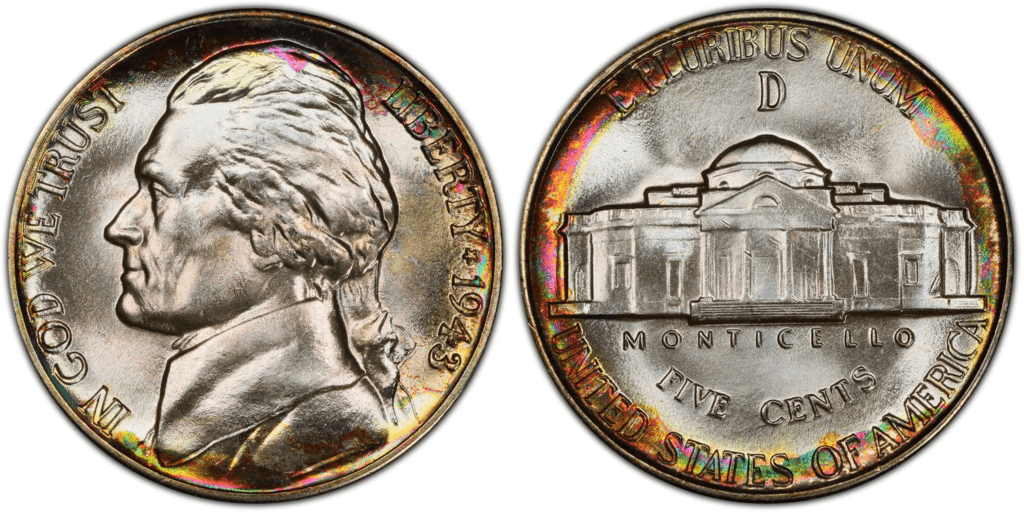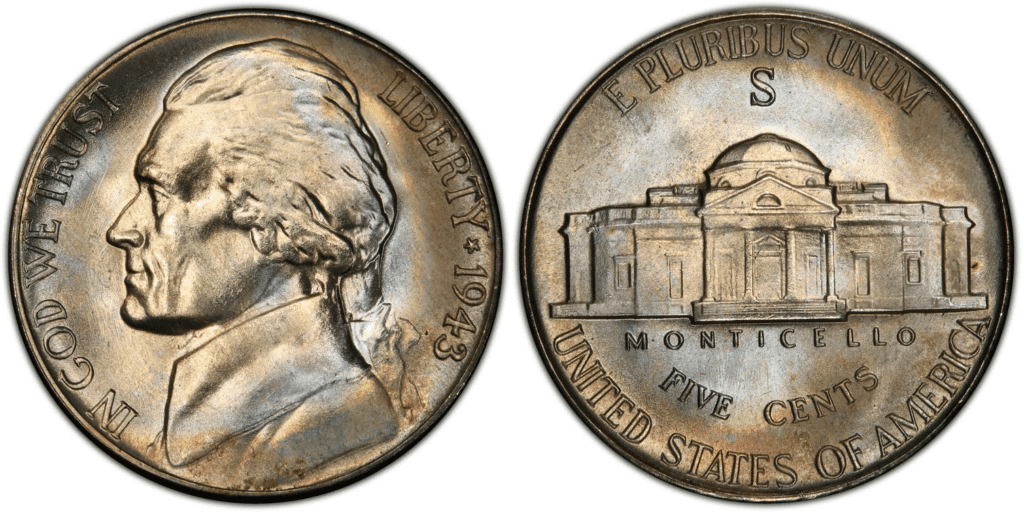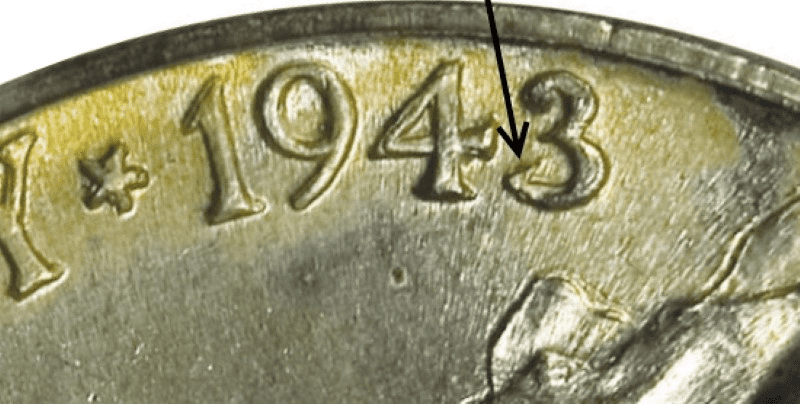What Is the 1943 Jefferson Nickel Made Of?
The 1943 Jefferson nickel is a war nickel. Normally, the nickel coin contains 75% copper and 25% nickel. However, the Jefferson nickel struck from mid-1942 to 1945 was made of 56% copper, 35% silver, and 9% manganese.
Due to the increased demand for nickel during World War II, the US Mint decided to reduce the nickel content of the 5-cent coin. Thus, it transitioned to a different composition in 1943.
The Jefferson nickel was first struck in 1938. It replaced the Buffalo nickel. The original design of the Jefferson nickel was made by Felix Oscar Schlag, a German-born American sculptor.

When it comes to design, the 1943 Jefferson nickel features the image of Thomas Jefferson, the third president of the United States. Inscriptions include the following:
- IN GOD WE TRUST
- LIBERTY
- 1943
On the reverse, you’ll find the mansion of Jefferson, the Monticello. Unlike other series, the 1943 nickel shows a bigger mint mark above the mansion’s dome.
Inscriptions include the following:
- E PLURIBUS UNUM
- MONTICELLO
- FIVE CENTS
- UNITED STATES OF AMERICA
- Mint mark (D, P, or S)
The original design of Schlag was used from the time it was struck in 1943 until 2004. It was replaced by a design made by Jamie Frankl in 2005. However, the reverse remained essentially the same except in 2004 and 2005, when commemorative designs were used.
1943 Jefferson Nickel Varieties
The 1943 Jefferson Nickel is among the most popular coins in the US, and it is still in production until this day. In 1943, there were three official issues of the 1943 Jefferson nickels. These include the following:
- 1943-S Jefferson Nickel
- 1943-D Jefferson Nickel
- 1943-P Jefferson Nickel
Here’s a table that compares the mintage figure for each variety:
| Variety | Location | Mintage |
| 1943-S Jefferson Nickel | San Francisco | 104,060,000 |
| 1943-D Jefferson Nickel | Denver | 15,294,000 |
| 1943-P Jefferson Nickel | Philadelphia | 271,165,000 |
| Total | 390,519,000 |
With that said, here’s a deeper look at the different varieties of 1943 nickel coins:
1943 D Jefferson Nickel
Edge: Smooth
Mint Mark: D
Place of minting: Denver
Year of minting: 1943
Face Value: $0.05 (five cents)
Price: $1.25 to $1,150 (or more)
Quantity produced: 15,294,000
Designer: Felix Schlag
Composition: 56% Copper, 35% Silver and 9% Manganese
Mass: 5 grams
Diameter: 21.21 mm
Thickness: 1.95 mm

photo source: PCGS
The 1943-D Jefferson nickel is known to be the most abundant variety of war-time nickels in Mint State. There are enough MS-67 examples to choose from. What’s so great about the 1943-D is that they are beautifully struck. In fact, this is one of the rare occasions when there are a lot of coin examples that were certified with a Full-Step category, which is more than the non-Full Steps.
A 1943 nickel could range from $1.25 to $1,150. It can be more expensive when sold in the open market.
1943 P Jefferson Nickel
Edge: Smooth
Mint Mark: P
Place of minting: Philadelphia
Year of minting: 1943
Face Value: $0.05 (five cents)
Price: $1.25 to $1,150 (or more)
Quantity produced: 271,165,000
Designer: Felix Schlag
Composition: 56% Copper, 35% Silver and 9% Manganese
Mass: 5 grams
Diameter: 21.21 mm
Thickness: 1.95 mm

photo source: PCGS
At the end of 1943, the Philadelphia Mint produced more than 271 million nickels. This is by far the highest mintage figure among the wartime nickels. Because of the massive number of this variety, there are a lot of beautifully preserved coins saved by speculators and collectors. For example, you should easily find 1943-P nickels with a grade up to MS-66. There are even a lot of Full Steps examples.
A 1943 nickel from the Philadelphia Mint can be $1.25 to $1,150.
1943 S Jefferson Nickel
Edge: Smooth
Mint Mark: S
Place of minting: San Francisco
Year of minting: 1943
Face Value: $0.05 (five cents)
Price: $1.25 to $950 (or more)
Quantity produced: 104,060,000
Designer: Felix Schlag
Composition: 56% Copper, 35% Silver and 9% Manganese
Mass: 5 grams
Diameter: 21.21 mm
Thickness: 1.95 mm

photo source: PCGS
At the end of 1943, the Philadelphia Mint produced more than 271 million nickels. This is by far the highest mintage figure among the wartime nickels. Because of the massive number of this variety, there are a lot of beautifully preserved coins saved by speculators and collectors. For example, you should easily find 1943-P nickels with a grade up to MS-66. There are even a lot of Full Steps examples.
A 1943 nickel from the Philadelphia Mint can be $1.25 to $1,150.
List Of 1943 Jefferson Nickel Errors
As mentioned earlier, more than 390 million Jefferson nickels were produced in 1943. So, there’s always a chance that an error coin would occur. Aside from that, some mechanical problems in the minting process made the coins look less impressive.
The most common error is the repunched mintmarks (RPMs). This happens when the die that punches the mintmark leaves two offset impressions. Although this might happen often, it is not always a big issue since the impressions overlap with each other. However, there are rare occasions when the repunched mintmarks become obvious. Prominent RPMs are seen to be valuable.
Here’s what the 1943 Jefferson nickel RPM errors may look like:
Image source: NGC
Another problem is the doubled die obverse (DDO) or doubled die reverse (DDR). Like the repunched mintmark, the DDO and DDR happen when the die strikes the planchet twice. Again, the error isn’t always obvious, but they become very valuable when they do.
Here’s what the 1943 nickel doubled die error looks like:
Image source: PCGS
As you can see here, the doubling is most prominent in the eyes of Jefferson and on the inscriptions “IN GOD WE TRUST,” “1943,” and “LIBERTY.”
Most DDRs or DDOs can only be seen under microscopes and magnifying glasses. However, the coin’s value increases when the error is obvious.
Perhaps, the most interesting error coin from the 1943 Jefferson nickel series is the 1943/2 Nickel. It’s an overdate that only happened in 1943. Here’s how it looks:
Image source: PCGS
This happened because Philadelphia resued the die from 1942. When the die struck the planchet, the number 3 in the inscription, 1943, seems to be an added tail, as seen in the image above.
The error was first discovered in 1948, but it was only in 1977 that more and more examples of this error were discovered. Since then, over a thousand examples have surfaced to have this error. The auction record for this error coin is $16,675, which was sold in June 2008.
How Much Is The 1943 Jefferson Nickel Worth Today?
The 1943 Jefferson nickel has a face value of 5 cents. Its mint value is a little higher since it has silver content. The melt value is around $1.3554, which can increase or decrease depending on the market value of silver and other metals.
Yes, the melt value, especially the face value, is too low. Nevertheless, don’t let that fool you. There are 1943 Jefferson nickel coins that were sold for hundreds and even thousands of dollars.
Here’s a values chart to help you better understand the worth of a 1943 Jefferson 5-cent coin:
| Coin | Condition | Grade | Mintage | Value |
| 1943 D Jefferson Nickel | Good | G-4 to G-6 | 15,294,000
|
$1.25 |
| 1943 D Jefferson Nickel | Fine | F-12 to F-15 | 15,294,000
|
$1.45 |
| 1943 D Jefferson Nickel | Extremely Fine | XF-40 to XF-45 | 15,294,000
|
$2 |
| 1943 D Jefferson Nickel | Uncirculated | MS-60 to MS-62 | 15,294,000
|
$3.75 |
| 1943 D Jefferson Nickel | Gem Uncirculated | MS-65 to MS-66 | 15,294,000
|
$19 to $67 |
| 1943 D Jefferson Nickel | Superb Gem Uncirculated | MS-67 to MS-68 | 15,294,000
|
$51 to $1,410 |
| 1943 D Jefferson Nickel | Superb Gem Uncirculated – Full Step | MS-67 to MS-68 | 15,294,000
|
$75 to $5,288 |
| 1943 S Jefferson Nickel | Good | G-4 to G-6 | 104,060,000 | $1.25 |
| 1943 S Jefferson Nickel | Fine | F-12 to F-15 | 104,060,000 | $1.45 |
| 1943 S Jefferson Nickel | Extremely Fine | XF-40 to XF-45 | 104,060,000 | $2 |
| 1943 S Jefferson Nickel | Uncirculated | MS-60 to MS-62 | 104,060,000 | $3.75 |
| 1943 S Jefferson Nickel | Gem Uncirculated | MS-65 to MS-66 | 104,060,000 | $228 to $920 |
| 1943 S Jefferson Nickel | Superb Gem Uncirculated | MS-67 | 104,060,000 | $646 to $1,064 |
| 1943 S Jefferson Nickel | Superb Gem Uncirculated – Full Step | MS-67 | 104,060,000 | $2,990 to $11,500 |
| 1943 P Jefferson Nickel | Good | G-4 to G-6 | 271,165,000 | $1.25 |
| 1943 P Jefferson Nickel | Fine | F-12 to F-15 | 271,165,000 | $1.45 |
| 1943 P Jefferson Nickel | Extremely Fine | XF-40 to XF-45 | 271,165,000 | $2 |
| 1943 P Jefferson Nickel | Uncirculated | MS-60 to MS-62 | 271,165,000 | $4.50 |
| 1943 P Jefferson Nickel | Gem Uncirculated | MS-65 to MS-66 | 271,165,000 | $11 to $105 |
| 1943 P Jefferson Nickel | Superb Gem Uncirculated | MS-67 | 271,165,000 | $84 to $1,234 |
| 1943 P Jefferson Nickel | Superb Gem Uncirculated – Full Step | MS-67 to MS-68 | 271,165,000 | $170 to $14,688 |
You can see on the table how valuable the 1943 nickels can be. Nevertheless, you would even see how much they can be sold for by looking at the auction records for each variety:
- $14,688 – a 1943-P 5C, FS (Regular Strike) coin with a grade of MS68FS sold in July 2020 by Legend Rare Coin Auctions
- $11,500 – a 1943-P 5C Doubled Die Obverse, FS (Regular Strike) coin with a grade of MS67 sold in April 2009 by Heritage Auctions
- $6,600 – a 1943-D 5C, FS (Regular Strike) coin with a grade of MS67+FS sold in March 2020 by Stack’s Bowers
How Does The Grading System Work?
The Sheldon Scale is used by numismatists to provide a numerical value to coins. The Sheldon Scale goes from poor (P-1) to perfect mint state (P-1) (MS-70). Coins were originally evaluated using words to reflect their condition (Good, Fair, Excellent, Etc.). Unfortunately, coin collectors and dealers had different ideas about what each of these terms represent.
Professional numismatists joined together in the 1970s and established CoinGrading standards. These numismatists now assign grades at key places on the seventy-point scale, using the most regularly utilized numeric points in conjunction with the original adjective grade. The following are the most common coin grades:
-
-
- (P-1) Poor – Indistinguishable and probably damaged; if used, must have a date and mintmark; otherwise, rather battered.
- (FR-2) Fair – Nearly smooth, but without the damage that a coin graded Poor often possesses. The coin must have enough detail to be identified.
- (G-4) Fair – Inscriptions have merged into the rims in some areas, and important elements have been mostly erased.
- (VG-8) Very Good- A little weathered, but all of the primary design elements are visible, albeit faintly. There is little if any, central detail left.
- (F-12) Good – The item is very worn, yet the wear is even, and the overall design details stand out clearly. Rims are almost completely isolated from the field.
- (VF-20) Very Fine – Moderately weathered, with some finer features still visible. The motto or all letters of LIBERTY are readable. Both sides of the coin have entire rims that are separated from the field.
- (EF-40) Extremely Fine – Gently used; all gadgets are visible, and the most important ones are bold. The finer details are bold and clear, however, light wear may be seen.
- (AU-50) Uncirculated – Slight evidence of wear on the coin’s design’s high points; may have contact marks; eye appeal should be adequate.
- (AU-58) Uncirculated Choice – Slight traces of wear, no severe contact marks, almost full mint shine, and great eye appeal.
- (MS-60) Mint State Basal – Strictly uncirculated; no indication of wear on the coin’s highest points, but an unsightly coin with reduced luster, visible contact marks, hairlines, and other flaws.
- (MS-63) Mint State Acceptable – Uncirculated, but with contact scratches and nicks, little reduced shine, but otherwise appealing appearance. The strike is weak to average.
- (MS-65) Mint State Choice – Uncirculated with great mint shine, very little contact blemishes, and exceptional eye appeal. The strike is unusually severe.
- (MS-68) Mint State Premium Quality – Uncirculated with superb luster, no obvious contact marks to the naked eye, and exceptional eye appeal. The strike is quick and appealing.
- (MS-69) Almost Perfect Mint State – Uncirculated with perfect brilliance, a sharp and appealing strike, and extremely good eye appeal. A near-perfect coin with minor imperfections in the planchet, strike, and contact markings (seen only under 8x magnification).
- (MS-70) Mint State Perfect – Under 8x magnification, there are no tiny imperfections discernible; the strike is crisp, and the coin is perfectly centered on a beautiful planchet. Rarely seen on a coin, this coin is bright and whole, with original luster and exceptional eye appeal.
-
Where To Buy Or Sell 1943 Jefferson Nickel?
There are different places where you can buy or sell 1943 Jefferson nickels. The quickest way to do it is through the Internet. Some of the best websites would include the following:
- eBay
- Amazon
- Grey Sheet
- Coin Appraiser
- JM Bullion
Aside from the Internet, you can visit coin shops, pawnshops, antique stores, and auction houses. You can join groups or clubs of coin collectors too. The more people you know, the more your chances of selling or buying coins.
FAQs
What is a 1943 2 P nickel?
The 1943/2-P five cents were struck in the Philadelphia Mint in 1943 and are the only recognized overdate in the entire Jefferson series. It’s an error coin that happened when the Philadelphia Mint reused a die that had 1942 on it. Thus, when you look at the 1943/2 P nickel, you’ll see a small trace of the number 2 under the number 3 in 1943.
Does a 1943 nickel have silver in it?
The 1943 nickel has 35% silver content. The rest of the content includes 56% copper and 9% manganese.
Is a 1943 P nickel rare?
There were more than 270 million 1943 P nickels, probably making it the most common nickel during World War II. However, there are rare 1943 P nickels. These nickels are usually the ones with grades up to MS67 and those with unique errors, such as the 1943 overdate nickel.





